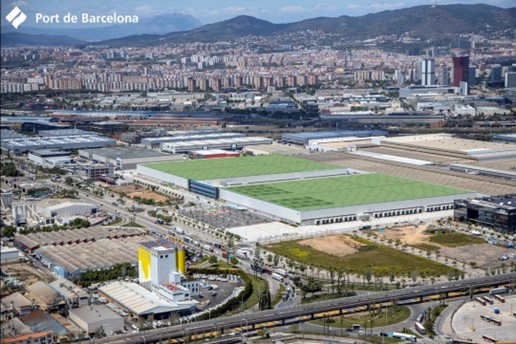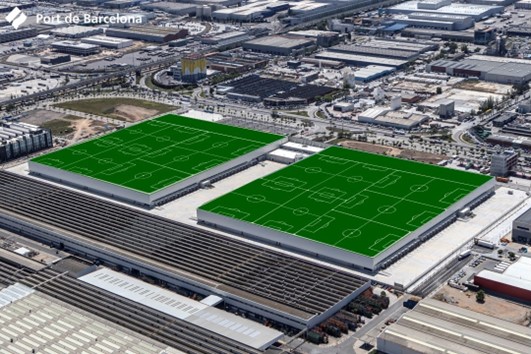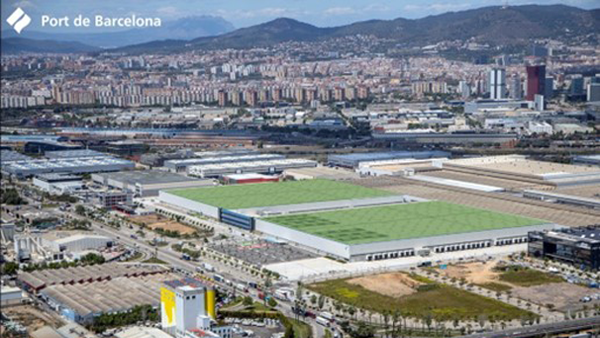- CILSA has begun to place the first photovoltaic installation of the ZAL Port, of 8.2 MWp of power, on the roof of the current Decathlon ship.
- Once all the photovoltaic installations planned for the ZAL Port are in operation, the installed power will be 40 MWp, generating the energy equivalent to the consumption of 41,250 people.
The ZAL Port, the Port of Barcelona’s intermodal logistics platform, will have the largest roof-top photovoltaic park in Europe. CILSA, the ZAL Port management company in which the Port of Barcelona and MERLIN Properties participate, has designed an ambitious project to install photovoltaic panels in most of the existing ships, an action that will be carried out in phases until 2026 and which is part of a plan to protect the environment and improve the efficiency in the use of natural resources.
The first step to build this large photovoltaic park on the roof was made this week with the start of the installation of solar panels in the building occupied by Decathlon. It is an installation for shared self-consumption of 91,692 square meters, the equivalent of 15 football fields, equipped with 19,846 panels that add up to a peak power of 8.2 MWp and an estimated production of 9,862.65 MWh/ year, equivalent to the consumption of 8,493 people.
This first photovoltaic installation adds up to an investment of around 6 million euros and will bring an outstanding environmental benefit, as it will allow a saving in emissions of 2,465 tons of CO2 per year, or what is the same: the emissions of 725 cars (12,000 km/year) in urban areas).
The second step in this CILSA plan to turn the ZAL Port into an energetically self-sufficient and environmentally sustainable logistics hub will consist of the installation of solar panels in different warehouses of the ZAL Prat (the area of the ZAL Port located in municipality of Prat de Llobregat) capable of guaranteeing 100% of the energy consumption of this entire area. Subsequently, the necessary facilities will be built to supply 100% of the energy consumed in the ZAL Port Barcelona (area of the ZAL Port located in the municipal area of Barcelona). And, finally, panels will be installed in practically the entire logistics hub, which will allow not only to supply 100% of the energy that is consumed in the entirety of this logistics center but also to generate green energy intended for to consumption by the Port Community and the Port of Barcelona itself.
Once all the photovoltaic installations planned for the ZAL Port come into operation, CILSA will have installed 40MWp of power and estimates that 50,000 MWh/year of electricity will be generated, the equivalent of the annual consumption of 41,250 people. This means generating the electrical energy needed to supply cities the size of Vilafranca del Penedès or Igualada throughout the year. Or entire neighborhoods of Barcelona, such as Vila Olímpica or Trinitat Nova. This was announced today by the president of the Port of Barcelona and CILSA, Lluís Salvadó; the CEO of MERLIN Properties, Ismael Clemente, and the general director of CILSA, Jordi Guerrero, during the presentation of the company’s photovoltaic energy development plan.
Lluís Salvadó has pointed out that the development of this photovoltaic installation is a new example of the commitment of the Port of Barcelona and the entire Port Community to decarbonisation. We are the economic infrastructure of the country that makes the most effort and investment to reduce emissions into the atmosphere, betting on both photovoltaic energy and the electrification of docks or the development of new fuels, among others. In the field of photovoltaic energy, the Port of Barcelona is working as hard as possible to achieve a photovoltaic production capacity in existing buildings and roofs within the port territory of between 92 and 100 MW of power and an annual electrical production of between 120 and 150 GWh. Around 10% of the capacity of this first phase (10 MW) is currently in operation. In a second phase, between 150 and 300 MW of additional power (between 190 and 350 GWH of annual electricity production) could be achieved in the new developments planned within the port precinct.
Ismael Clemente, for his part, commented that “the three pillars of MERLIN’s commitment to sustainability are the active management of climate change, the well-being of the end user and the positive impact on cities. And the energy transition towards sources of renewable origin plays a fundamental role. We have been pioneers in the real estate sector with our project to install photovoltaic panels in our asset portfolio with the aim of being the largest producer of photovoltaic energy in self-consumption installations in the Iberian Peninsula in the sector and the plan designed by CILSA for the ZAL Port means taking a new step in this direction”.
Jordi Guerrero explained that “CILSA has focused its efforts in recent years on the development, construction and management of almost 1,000,000 m² of leading warehouses in energy efficiency and sustainable construction to set up a modern logistics park that respects the environment Today, we start a strong commitment towards the energy transition with the installation of up to 450,000 m² of photovoltaic panels and the goal of providing all our customers with the green energy necessary to cover 100% of the needs operational and reduce to zero the emissions of the ZAL Port generated by our logistics activity and by the services we provide”.
PHOTOS:
Rendering of the warehouse occupied by Decathlon in which the installation of photovoltaic panels has begun.

The building currently occupied by Decathlon will have an installation of solar panels for shared self-consumption of 91,692 square meters, the equivalent of 15 football fields.

 [+34] 93 552 58 26
[+34] 93 552 58 26 sac@zalport.com
sac@zalport.com Av. Ports d'Europa 100, Planta 0, 08040. Barcelona
Av. Ports d'Europa 100, Planta 0, 08040. Barcelona






